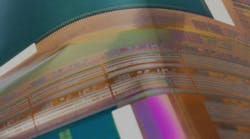Download this article in PDF format.
First, can you tell us a little about imec?
Founded in 1984 in Leuven, Belgium, imec is an R&D and innovation hub in nanoelectronics and digital technologies. Our company offers R&D solutions to create new technologies and innovation services for both products and services. By leveraging world-class infrastructure and local and global ecosystem of partners across a multitude of industries, imec creates groundbreaking innovation in application domains, such as healthcare, smart cities and mobility, logistics and manufacturing, and energy.
The combination of advanced microchip technologies and state-of-the-art software expertise is what makes imec unique. The evolution in microchip technology toward more powerful and smaller chips allows us to make every object intelligent and bring tons of data to our fingertips.
imec pioneers compact, high-throughput, and power-efficient design solutions for next-generation wireless communication. Our portfolio includes millimeter-wave phased-array transceivers, record-breaking analog-to-digital converter (ADCs), reconfigurable low-noise frequency synthesizers, tunable duplexers, and more. Our solutions cover the entire spectrum of wireless communication ranging from LTE to 5G.
Kris Myny, Principal Member of Technical Staff, imec
In addition to our headquarters in Belgium, imec has research facilities in the Netherlands, Taiwan, China, and India, as well as offices in Japan and the U.S. In 2016, imec opened a new facility in Florida—a design center facilitating collaboration between imec's headquarters in Leuven and U.S.-based semiconductor and system companies, universities, and research institutes.
The initial focus of the new facility will be R&D of high-speed electronics and photonics solutions. It will start with IC design research for a broad set of semiconductor-based solutions such as terahertz (THz) and LIDAR (light detection and ranging) sensors and imagers.
Recently, imec introduced its near-field-communications (NFC) tag that is manufactured with thin-film transistor technology. How will this technology impact NFC-based products?
Metal-oxide thin-film transistors represent a widespread transistor technology mainly used today as switches in active matrix displays, like AM-OLED and AM-LCD. In addition, at imec, we investigate the applicability of metal-oxide transistor technology in flexible integrated-circuit applications, like low-cost RFID/NFC tags and microprocessors on foil.
The key challenge for metal-oxides is to achieve sufficient performance required for those applications, given the µm channel lengths and a charge carrier mobility of around 10 cm²/Vs. Our recent demonstration of the world’s first flexible metal-oxide NFC tag, read out by a commercial smartphone, is therefore a big milestone for the field, showcasing for the first time metal-oxide thin-film circuits that comply with ISO standards.
This low-cost, ultra-thin, flexible NFC technology enables a seamless integration into everyday objects for Internet of Things (IoT) applications. An object can connect to the cloud using the smartphone as a hub and NFC as communication medium. It can be simple identification of the object, like NFC-based playing cards interacting with smartphones and tablets (referring to our developments together with our partner Cartamundi). Moreover, the object can contain sensor readout in the future, paving the way to revolutionize retail (like cold-chain monitoring, drone delivery...) and wearable health patches.
Can you talk about some of the developments taking place at imec for low-power IoT radios?
We cover a wide range of IoT applications, from consumer health and well-being to smart homes/ buildings/cities and industrial applications. We empower new applications by drastically reducing power consumption for wireless connectivity, enabling operation from small batteries or energy harvesters and smaller device form factors.
Our radios target ultra-low-power consumption, state-of-the-art performance, and low-cost implementations, including Bluetooth Low Energy (BLE) 4.0/4.2/5.0, IEEE 802.15.4 (ZigBee, Thread), IEEE 802.11b/g/n (Wi-Fi) and IEEE 802.11ah (Wi-Fi HaLow).


